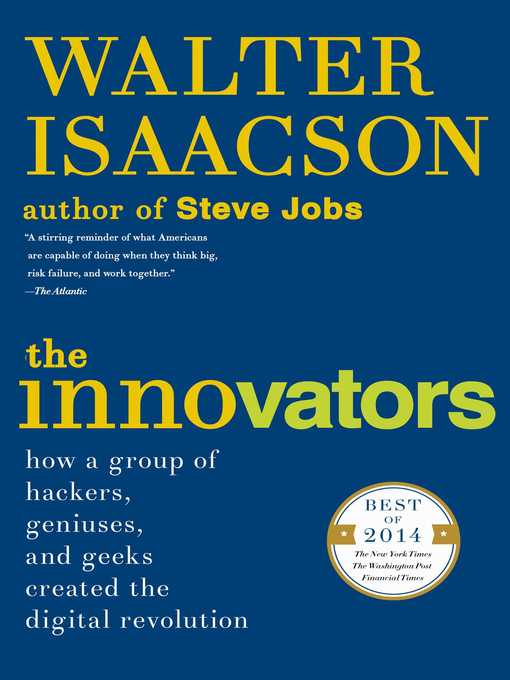
The Innovators
How a Group of Hackers, Geniuses, and Geeks Created the Digital Revolution
کتاب های مرتبط
- اطلاعات
- نقد و بررسی
- دیدگاه کاربران
نقد و بررسی

Starred review from August 4, 2014
The history of the computer as told through this fascinating book is not the story of great leaps forward but rather one of halting progress. Journalist and Aspen Institute CEO Isaacson (Steve Jobs) presents an episodic survey of advances in computing and the people who made them, from 19th-century digital prophet Ada Lovelace to Google founders Larry Page and Sergey Brin. His entertaining biographical sketches cover headline personalities (such as a manic Bill Gates in his salad days) and unsung toilers, like WWII’s pioneering female programmers, and outright failures whose breakthroughs fizzled unnoticed, such as John Atanasoff, who was close to completing a full-scale model computer in 1942 when he was drafted into the Navy. Isaacson examines these figures in lucid, detailed narratives, recreating marathon sessions of lab research, garage tinkering, and all-night coding in which they struggled to translate concepts into working machinery. His account is an antidote to his 2011 Great Man hagiography of Steve Jobs; for every visionary—or three (vicious fights over who invented what are ubiquitous)—there is a dogged engineer; a meticulous project manager; an indulgent funder; an institutional hothouse like ARPA, Stanford, and Bell Labs; and hordes of technical experts. Isaacson’s absorbing study shows that technological progress is a team sport, and that there’s no I in computer. Photos. Agent: Amanda Urban, ICM.

September 15, 2014
Isaacson (Steve Jobs) is a storyteller of the kind he admires among the people who made the bits and pieces that would become computers, wrote programs, invented games, miniaturized the computer, created the Internet, and found ways for ordinary people to access technology and build communities. The author relates the history of the computer by describing these individuals vividly and succinctly. Most were brilliant. Some were shy, others wild. Many had flaws. All are fascinating. At each crucial point in the development of the machine, explains Isaacson, there were usually several people who worked almost as one, even though their personalities differed considerably: an engineer carefully planned the steps, a manager kept people on track, and a pied piper involved others. Ada Lovelace is an example of the visionaries covered in the book; the outlook detailed in her 1843 Notes on Babbage's Analytical Engine took 160 years to be realized, but Lovelace's predictions describe our world today, where humans and machines work together in the arts and sciences to create new knowledge and solve old problems. As well as relevant personalities, Isaacson's work describes organizations and corporations with similar color and clarity. The volume lacks an index, and with many people and concepts mentioned more than once, it would be fascinating to reference these connections (a searchable electronic file would be a logical and helpful addition). VERDICT Anyone who uses a computer in any of its contemporary shapes or who has an interest in modern history will enjoy this book. It should be on the reading lists of book discussion groups and high school and college courses across the curriculum.--Linda Loos Scarth, Cedar Rapids, IA
Copyright 2014 Library Journal, LLC Used with permission.

Starred review from September 15, 2014
In 1843, Ada Lovelace, the daughter of Lord Byron, wrote in a letter to Charles Babbage that mathematical calculating machines would one day become general-purpose devices that link the operations of matter and the abstract mental processes, correctly predicting the rise of modern computers. Thus begins a remarkable overview of the history of computers from the man who brought us biographies of Steve Jobs, Benjamin Franklin, Albert Einstein, and Henry Kissinger. The story is above all one of collaboration and incremental progress, which lies in contrast to our fascination with the lone inventor. Here we find that in a world dominated by men with their propensity for hardware, the first contributions to software were made by women. While we have those storied partnerships of the digital age Noyce and Moore, Hewlett and Packard, Allen and Gates, and Jobs and Wozniakall of their contributions were built upon the advances of lesser-known pioneers, who are heralded in these pages. Although full biographies of the individuals profiled here have been written in spades, Isaacson manages to bring together the entire universe of computing, from the first digitized loom to the web, presented in a very accessible manner that often reads like a thriller.(Reprinted with permission of Booklist, copyright 2014, American Library Association.)

























دیدگاه کاربران